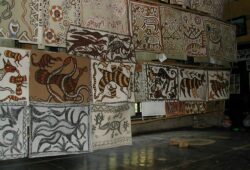Exploring Pop Art: A Fusion of Popular Culture and Artistic Expression
 Posted On
Posted On
Pop art emerged in the mid-1950s as a revolutionary artistic movement that challenged traditional notions of art by incorporating popular culture and consumerism into its creations. Led by influential artists such as Andy Warhol and Roy Lichtenstein, pop art celebrated mass-produced imagery, advertising, and everyday objects as subjects worthy of artistic exploration. In this article, we will delve into the origins, key characteristics, and lasting impact of pop art on the art world and popular culture.
Origins of Pop Art: Pop art originated in the United Kingdom and the United States in the post-World War II era, a time characterized by an explosion of consumerism and the rise of mass media. The movement was a response to the dominant abstract expressionism of the time, which focused on expressing individual emotions through non-representational forms. Pop artists sought to break away from the elitism of the art world and create works that were accessible and relevant to a broader audience.
Key Characteristics: One of the defining features of pop art is its use of everyday objects and popular imagery as subject matter. Artists drew inspiration from the world of advertising, comic books, celebrities, and consumer products. They often depicted familiar objects or icons, such as soup cans, Coca-Cola bottles, Marilyn Monroe, or comic book characters, in bold and vibrant colors.
Another characteristic of pop art is its use of techniques borrowed from mass production, such as screen printing and collage. Artists embraced the mechanical reproduction of images to create multiples of their works, blurring the line between fine art and commercial production. This approach challenged the notion of the unique, one-of-a-kind artwork traditionally valued in the art world.
Impact and Legacy: Pop art had a profound impact on the art world and popular culture. By elevating mass-produced objects and popular imagery to the realm of high art, pop artists challenged the notion of what could be considered art. They democratized the artistic process, making it accessible to a broader audience and breaking down the barriers between high and low culture.
The movement also offered a critique of consumerism and the media’s influence on society. Artists like Warhol, with his iconic Campbell’s soup can paintings and celebrity portraits, questioned the role of advertising and fame in shaping public perception. They brought attention to the power of mass media and the way it shapes our desires and identities.
Pop art’s influence extends far beyond the art world. Its visual language and appropriation of popular culture have been embraced by advertising, fashion, and graphic design. Elements of pop art can be seen in contemporary art movements, such as street art and digital art, where artists continue to explore the relationship between popular culture and artistic expression.
Pop art revolutionized the art world by challenging traditional notions of art and embracing the imagery and objects of popular culture. It celebrated the mundane, the mass-produced, and the everyday, elevating them to the status of art. Pop art continues to inspire and influence artists and designers, reminding us of the power of popular culture and its enduring impact on society.



